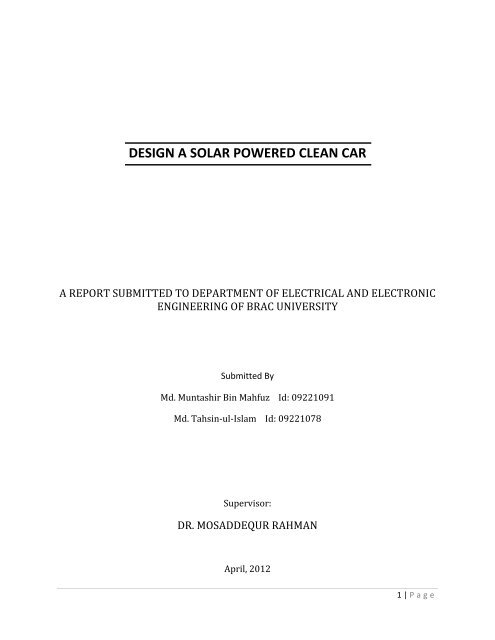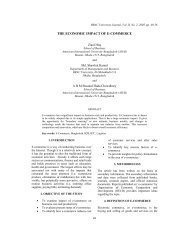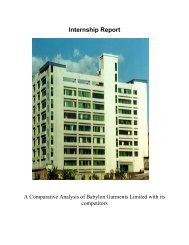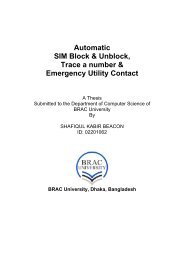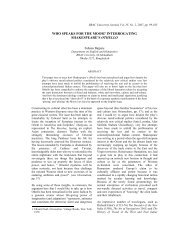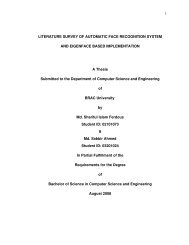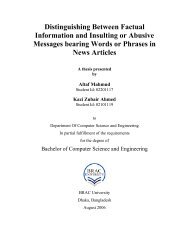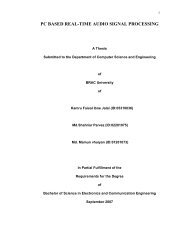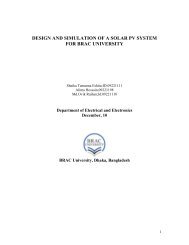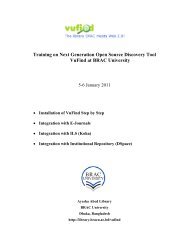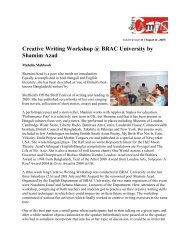design a solar powered clean car - of DSpace - BRAC University
design a solar powered clean car - of DSpace - BRAC University
design a solar powered clean car - of DSpace - BRAC University
Create successful ePaper yourself
Turn your PDF publications into a flip-book with our unique Google optimized e-Paper software.
DESIGN A SOLAR POWERED CLEAN CAR<br />
A REPORT SUBMITTED TO DEPARTMENT OF ELECTRICAL AND ELECTRONIC<br />
ENGINEERING OF <strong>BRAC</strong> UNIVERSITY<br />
Submitted By<br />
Md. Muntashir Bin Mahfuz Id: 09221091<br />
Md. Tahsin‐ul‐Islam Id: 09221078<br />
Supervisor:<br />
DR. MOSADDEQUR RAHMAN<br />
April, 2012<br />
1 | P age
Md.<br />
Muntashir Bin Mahfuz<br />
Id:<br />
09221091<br />
Md. Tahsin‐ul‐ Islam<br />
Id: 09221078<br />
DR. MOSADDEQUR RAHMAN<br />
Assistant pr<strong>of</strong>essor<br />
Department <strong>of</strong> Electrical and Electronic Engineering<br />
<strong>BRAC</strong> <strong>University</strong><br />
2 | P age
1.<br />
2.<br />
3.<br />
Table <strong>of</strong> Contents:<br />
1.1 Fuel problem in Bangladesh<br />
Introduction<br />
06<br />
1.2 Electric vehicle 06<br />
1.3 Power shortage problems in Bangladesh 07<br />
1.4 Renewable energy to fight against fuel problem 08<br />
1.5 Solar power is the best as Renewable energy 08<br />
1.6 Solar power <strong>car</strong> 08<br />
1.7 Why do not <strong>design</strong> <strong>solar</strong> power <strong>car</strong> 09<br />
Pollution in Dhaka city Calculation<br />
2.1 Peak hour <strong>car</strong> load calculation 09<br />
2.2<br />
Average mileage and odometer reading <strong>of</strong> <strong>car</strong> in<br />
Dhaka city<br />
11<br />
2.3 Total amount <strong>of</strong> pollution a <strong>car</strong> generates each year 12<br />
2.4 Pollution on top point <strong>of</strong> Dhaka (Peak Hour) 12<br />
2.5<br />
Comparison with the safe pollution limit <strong>of</strong><br />
developed countries<br />
13<br />
2.6 Exceeding noise pollution 14<br />
Designing <strong>of</strong> the Car<br />
3.1 Study about the Electric Vehicles in Bangladesh 14<br />
3.2 Block diagram <strong>of</strong> the <strong>car</strong><br />
Photovoltaic panels<br />
3.3.1 Types <strong>of</strong> photovoltaic panels<br />
14<br />
3.3<br />
•<br />
•<br />
Mono crystalline silicon<br />
Poly crystalline silicon<br />
15‐16<br />
• String ribbon<br />
• Thin film<br />
3.4 Real vehicle outside area survey 16<br />
3.5 Selecting <strong>of</strong> <strong>solar</strong> panel<br />
Battery<br />
3.6.1 Solar system battery<br />
3.6.2 Available types <strong>of</strong> batteries<br />
19<br />
3.6<br />
•<br />
•<br />
Marine type deep cycle battery<br />
Lead‐ acid battery<br />
19‐21<br />
• AGM battery<br />
• Gel battery<br />
3.6.3 DC battery selection<br />
Motor<br />
3.7 • Brushed DC motors<br />
21<br />
• Brushless DC motors<br />
3 | P age
4.<br />
5.<br />
3.7.1 Motor selection<br />
Challenges <strong>of</strong> implementation <strong>of</strong> <strong>solar</strong> panel<br />
3.8<br />
•<br />
•<br />
Power supply at night<br />
Charging at night and bad weather condition<br />
22<br />
• Solar panel cannot supply whole days’ energy<br />
3.9 Changes on block diagram 23<br />
3.10 Designing the <strong>car</strong> 23<br />
Implementation <strong>of</strong> small model<br />
4.1 Designing <strong>of</strong> small prototype 25<br />
Motor and battery selection for prototype<br />
4.2 • Motor<br />
26<br />
• Battery<br />
4.3 Charge controller 27<br />
4.4 Charge controller working principle<br />
Control <strong>of</strong> the <strong>car</strong><br />
4.5.1 Implementing gear train ratio<br />
27<br />
4.5<br />
4.5.2 Simple steering mechanism <strong>design</strong>ing<br />
and selection<br />
4.5.3 Starting and breaking system<br />
4.5.4 Reversing and front driving<br />
28‐31<br />
Future works<br />
5.1 Voltage controller <strong>design</strong> 31<br />
5.2 Motor controller <strong>design</strong> 32<br />
5.3 Implementing flexible <strong>solar</strong> panel 32<br />
5.4 Increasing vehicle size 32<br />
References<br />
6. 6 References 33<br />
4 | P age
Abstract<br />
Prior to year 2000, most vehicles in Bangladesh were used to run on petroleum. Though we have<br />
to import it and in international market the demand <strong>of</strong> petroleum oil is always higher than the<br />
supply and that’s why it is always expensive. In this case if we use <strong>solar</strong> based electric vehicle<br />
which is driven by electric motor that is much more cost efficient. But the problem is the <strong>solar</strong><br />
panel cannot supply the whole power that is needed to run the motor. So in the project we use<br />
additional battery which combinedly supplies power to motor. So that our <strong>design</strong> can be said as<br />
hybrid <strong>solar</strong> <strong>car</strong>. To develop our idea we will find out the external area <strong>of</strong> a <strong>car</strong> that where we<br />
can fix the <strong>solar</strong> panel, <strong>design</strong>ing a new vehicle, working on battery charger, voltage and motor<br />
controller Above all we will try to <strong>design</strong> and implement a cost effective hybrid <strong>solar</strong> <strong>car</strong> which<br />
will be pollution and noise free.<br />
5 | P age
1.1 FUEL PROBLEM IN BANGLADESH<br />
INTRODUCTION<br />
Prior to year 2000, most vehicles in Bangladesh were used to run on petroleum. Petroleum oil is<br />
not a natural resource <strong>of</strong> Bangladesh, so that each year we have to import it. In international<br />
market the demand <strong>of</strong> petroleum oil is always higher than the supply and that’s why it is always<br />
expensive. Though Bangladesh government subsidies petroleum oil, but because <strong>of</strong> increasing<br />
the price <strong>of</strong> petroleum oil in world market, the price <strong>of</strong> petroleum in our country is increasing<br />
day by day. An alternative solution <strong>of</strong> this problem was found in 2000 and CNG automobiles<br />
were launched in Bangladesh which are run in natural gas. But the reserve <strong>of</strong> natural gas <strong>of</strong><br />
Bangladesh is not high enough as well as new mine is not discovered and using natural gas in<br />
power plants this alternative solution is in danger.<br />
1.2 ELECTRIC VEHICLE<br />
An electric vehicle is <strong>powered</strong> by an electric motor where there is petrol/diesel engines are used<br />
in gasoline vehicle. They have only half the initial cost <strong>of</strong> a gasoline vehicle. The power <strong>of</strong><br />
electric vehicle is less than gasoline vehicle. But it is impossible to find out the difference among<br />
them while driving. While gasoline vehicle have a heavy noise and pollute the air, electric<br />
vehicle are smooth and silent and also have on pollution emits while driving. The idea <strong>of</strong> electric<br />
vehicle is new. The components <strong>of</strong> an electric vehicle are DC electric motors, Electric controller,<br />
Battery tray, 12V Lead acid batteries, Battery Charger and Many motors for driving smaller<br />
parts. Because <strong>of</strong> fuel problem in Bangladesh introducing electric vehicle is to reduce the<br />
pressure on fuel and our environment will be good enough. There is a comparison is given below<br />
to realize how much better an electric vehicle in comparison with gasoline vehicle.<br />
6 | P age
1.3 POWER SHORTAGE PROBLEMS IN BANGLADESH<br />
Bangladesh is facing electricity shortage problem for many years and this problem in increased<br />
in last few years and exceeded the general people’s patient. Geographically Bangladesh is<br />
located in tropical region so that except few month <strong>of</strong> the year, most <strong>of</strong> the part <strong>of</strong> the year is<br />
summer and it is a sunny day in morning. The temperature is rises up to 40 degree Celsius and it<br />
is unbearable to stay without electricity. Electricity is one <strong>of</strong> the major demands in all aspects <strong>of</strong><br />
our life though we cannot ensure 24 hours electricity supply. Almost <strong>of</strong> the whole year we are<br />
facing load shedding problem and it is unbearable in summer. Power Development Board (PDB)<br />
sources informed that the <strong>of</strong>ficially estimated power demand is now 5000MW against a<br />
generation <strong>of</strong> around 3500 MW.<br />
So in this type <strong>of</strong> circumstances it is not that much an effective idea to introduce electric vehicle<br />
in Bangladesh.<br />
7 | P age
1.4 RENEWABLE ENERGY TO FIGHT AGAINST FUEL PROBLEM<br />
Renewable energy comes from natural resources such as sunlight, wind, tides, rain and<br />
geothermal heat, which are all renewable. These energies are derived from natural processes that<br />
are restored constantly. Electrical energy is derived from <strong>solar</strong>, wind, ocean, hydropower,<br />
biomass, geothermal resources, bio-fuels and hydrogen. If we can use renewable energy to<br />
produce power for electric vehicle then it has no bad impact on our power shortage problem and<br />
as well as we reduce the pressure on using fuel.<br />
1.5 SOLAR POWER IS THE BEST AS RENEWABLE ENERGY<br />
Solar energy is the most effective energy supply for electric vehicle in comparing with other<br />
renewable energy source. Other source <strong>of</strong> renewable energy cannot be used in electric vehicle.<br />
The body frame <strong>of</strong> the vehicle can be used as <strong>solar</strong> plate from where the vehicle can get the total<br />
power. Bangladesh is situated between 20.30 - 26.38 degrees north and 88.04 - 92.44 degrees<br />
east which is an ideal location for <strong>solar</strong> energy utilization. Here <strong>solar</strong> radiation varies between 4<br />
to 6.5 kWh per square meter and maximum amount <strong>of</strong> radiation is available in summer. So for<br />
Bangladesh electric vehicle using <strong>solar</strong> power is most effective.<br />
1.6 SOLAR POWER CAR<br />
A <strong>solar</strong> vehicle is an electric vehicle <strong>powered</strong> by <strong>solar</strong> electricity. This is obtained from <strong>solar</strong><br />
panels on the surface (generally, the top or window) <strong>of</strong> the vehicle or using a <strong>solar</strong> jacket in<br />
electric bicycles. Photovoltaic (PV) cells convert the sun’s energy directly into electrical energy.<br />
Solar vehicles are not sold as practical day-to-day transportation devices at present, but are<br />
primarily demonstration vehicles and engineering exercises, <strong>of</strong>ten sponsored by government<br />
agencies. However indirectly <strong>solar</strong>-charged vehicles are widespread and <strong>solar</strong> boats are available<br />
commercially.<br />
Solar <strong>car</strong>s combine technology typically used in the aerospace, bicycle, alternative energy and<br />
automotive industries. The <strong>design</strong> <strong>of</strong> a <strong>solar</strong> vehicle is severely limited by the amount <strong>of</strong> energy<br />
input into the <strong>car</strong>. Most <strong>solar</strong> <strong>car</strong>s have been built for the purpose <strong>of</strong> <strong>solar</strong> <strong>car</strong> races. Exceptions<br />
include <strong>solar</strong>-<strong>powered</strong> <strong>car</strong>s and utility vehicles.<br />
Solar <strong>car</strong>s are <strong>of</strong>ten fitted with gauges as seen in conventional <strong>car</strong>s. In order to keep the <strong>car</strong><br />
running smoothly, the driver must keep an eye on these gauges to spot possible problems. Cars<br />
without gauges almost always feature wireless telemetry, which allows the driver's team to<br />
monitor the <strong>car</strong>'s energy consumption, <strong>solar</strong> energy capture and other parameters and free the<br />
driver to concentrate on driving.<br />
8 | P age
Solar <strong>car</strong>s depend on PV cells to convert sunlight into electricity. In fact, 51% <strong>of</strong> sunlight<br />
actually enters the Earth's atmosphere. Unlike <strong>solar</strong> thermal energy which converts <strong>solar</strong> energy<br />
to heat for either household purposes, industrial purposes or to be converted to electricity, PV<br />
cells directly convert sunlight into electricity. When sunlight (photons) strikes PV cells, they<br />
excite electrons and allow them to flow, creating an electrical current. PV cells are made <strong>of</strong><br />
semiconductor materials such as silicon and alloys <strong>of</strong> indium, gallium and nitrogen. Silicon is the<br />
most common material used and has an efficiency rate <strong>of</strong> 15-20%. Of late, several consulting<br />
companies, such as Phoenix Snider Power, have started <strong>of</strong>fering technical and financial services<br />
to institutes and teams developing <strong>solar</strong> <strong>car</strong>s worldwide.<br />
1.7 WHY DO NOT DESIGN SOLAR POWER CAR<br />
In our country most <strong>of</strong> the <strong>car</strong>s are imported from Japan and they are oil running vehicle. To<br />
reduce the cost <strong>of</strong> maintenance most users converts them into CNG running <strong>car</strong>. If we think<br />
about a common model <strong>of</strong> <strong>car</strong> like TOYOTA COROLLA it has 1496cc engine with front wheel<br />
drive VVT-i engine with a top speed <strong>of</strong> 180 km/h. It has a horse power <strong>of</strong> 110. If we convert the<br />
horse power into watt we get 82.06kw. Now the problem is if we want to <strong>design</strong> an equivalent<br />
<strong>car</strong> which has same horse power then we cannot get that much power from the <strong>solar</strong> panel, so<br />
that we have to supply the extra power from external battery. Then the total vehicle is no more a<br />
<strong>solar</strong> power <strong>car</strong>. Then that is shifted to a combined supply <strong>solar</strong> <strong>car</strong>. That’s why we are trying to<br />
<strong>design</strong> a combined supply <strong>solar</strong> <strong>car</strong>.<br />
POLLUTION IN DHAKA CITY CALCULATION<br />
Pollution in Dhaka city is increasing day by day due to increasing industrial unit as well as motor<br />
vehicles. Motor vehicles especially private vehicles are increasing weirdly day by day and<br />
because <strong>of</strong> these private vehicle traffic jam and pollution is increasing. Most <strong>of</strong> the private<br />
vehicles in Dhaka city are reconditioned and they emits excessive amount <strong>of</strong> hydro<strong>car</strong>bons and<br />
as well as particle materials.<br />
2.1 PEAK HOUR CAR LOAD CALCULATION<br />
In Bangladesh the traffic load is increasing day by day. But the traffic load is not same at all<br />
time. At morning from 8:00 a.m. to 11 a.m. and at evening from 4:00 p.m. to 8 p.m. the load <strong>of</strong><br />
vehicles in the road is much higher than the any other time. This is considering as peak hour for<br />
vehicles passing. For calculating <strong>car</strong> load in the Dhaka city we choose top four vehicle crossing<br />
point <strong>of</strong> Dhaka city as Mohakhali, Moghbazar, Shahbag and Firmgate. Here we take the data <strong>of</strong><br />
passing <strong>car</strong> in a minute and take three data likewise then find out the average and how much <strong>car</strong><br />
is passing in an hour at the peak hour.<br />
9 | P age
The following table is shown the peak hour <strong>car</strong> (private vehicle) load in Dhaka city.<br />
AREA ROAD<br />
MOHAKHALI<br />
10.02.2011<br />
(10:10 a.m.)<br />
FIRMGATE<br />
06.02.2011<br />
(4 p.m.)<br />
SHAHBAG<br />
06.02.2011<br />
(4:30 p.m.)<br />
MOGBAZAR<br />
06.02.2011<br />
(6:30 p.m.)<br />
Nabisco – Mohakhali –<br />
Banani<br />
CAR PASSES/min<br />
1 2 3<br />
AVG. CAR<br />
PASSES/min<br />
40 37 45 41<br />
Banani – Mohakhali 57 55 40 51<br />
Jahangir Gate –<br />
Mohakhali<br />
Flyover<br />
in<br />
out<br />
30 26 23 26<br />
30<br />
+<br />
34<br />
23<br />
+<br />
26<br />
32<br />
+<br />
33<br />
Bijoy Soroni – Firmgate 39 41 36 39<br />
Firmgate – Bijoy Soroni 47 42 44 44<br />
Khamar Bari – Firmgate 29 35 45 37<br />
Bangla Motor –<br />
Shahbag<br />
59<br />
50 57 55 54<br />
TSC – Shahbag 30 40 40 37<br />
Shisu Park – Katabon<br />
Katabon – Shisu Park<br />
Ramna Thana –<br />
Mogbazar<br />
Mogbazar Rail Crossing<br />
– Mogbazar<br />
Bangla Motor –<br />
Mogbazar<br />
Mogbazar – Bangla<br />
Motor<br />
43<br />
+<br />
32<br />
44<br />
+<br />
36<br />
30<br />
+<br />
42<br />
76<br />
44 35 46 42<br />
36 35 36 36<br />
19 16 24 20<br />
27 28 28 28<br />
TOTAL AVG.<br />
CAR<br />
PASSES/min<br />
AVG. CAR<br />
PASSES/hour<br />
177 10620<br />
120 7200<br />
167 10020<br />
126 7560<br />
10 | P age
2.2 AVERAGE MILEAGE AND ODOMETER READING OF CAR IN DHAKA CITY<br />
Most <strong>of</strong> the <strong>car</strong>s in Bangladesh are imported as reconditioned. Only very few are brand new.<br />
Because <strong>of</strong> this reason total mileage <strong>of</strong> these private vehicles are so large. The odometer reading<br />
shows the total mileage <strong>of</strong> a vehicle and then we find out the average mileage <strong>of</strong> these vehicles<br />
per year to calculate the polluting element that the vehicles emit.<br />
The table given below is shown the average mileage and odometer reading <strong>of</strong> some private<br />
vehicles.<br />
LICENCE NO.<br />
(DHAKA METRO)<br />
ODOMETER<br />
READING<br />
MILEAGE/PER<br />
DAY<br />
MILEAGE/PER<br />
YEAR<br />
GA‐141768 193493 25 09125<br />
GA‐172882 215415 31 11315<br />
KHA‐127582 065711 10 03650<br />
THA‐116534 141274 25 09125<br />
KHA‐121453 143099 50 18250<br />
GHA‐173969 200254 40 14600<br />
BHA‐111277 044280 44 16060<br />
GHA‐217835 063898 37 13505<br />
THA‐116903 099027 40 14600<br />
GA‐149855 001964 06 02190<br />
GA‐177239 118741 37 13505<br />
CA‐118523 169707 62 22630<br />
GA‐276263 070030 31 11315<br />
CA‐533780 054299 25 09125<br />
KHA‐111705 123375 22 08030<br />
GA‐148118 090037 40 09125<br />
GA‐293227 033972 07 02555<br />
CA‐515081 221099 68 24820<br />
GA‐258881 054589 50 18250<br />
KHA‐123812 050851 68 24820<br />
AVG.<br />
ODOMETER<br />
READING<br />
AVG.<br />
MILEAGE/PER<br />
YEAR<br />
107756 12830<br />
11 | P age
2.3 TOTAL AMOUNT OF POLLUTION A CAR GENERATES EACH YEAR<br />
In developed countries there are safe pollution standard for all types <strong>of</strong> public and private<br />
vehicles. Vehicle cannot run in the road if it fails in the test. But in our country there is no safe<br />
pollution limits as well as most <strong>of</strong> the vehicles are reconditioned. For limitation <strong>of</strong> equipments<br />
we are taking help <strong>of</strong> the websites and from where find out the pollution that a <strong>car</strong> generates each<br />
year.<br />
The table below is shown the total amount <strong>of</strong> pollution a <strong>car</strong> generates each year.<br />
Non Methane<br />
Hydro<strong>car</strong>bons<br />
(NMH)<br />
(kilograms)<br />
Carbon Monoxide<br />
(CO)<br />
(kilograms)<br />
Oxides <strong>of</strong> Nitrogen<br />
(NOx)<br />
(kilograms)<br />
Particulate Matter<br />
(PM)<br />
(kilograms)<br />
3.9773 53.886 7.698 1.0264000000000002<br />
Assuming a <strong>car</strong> is in the road on average 2.5 hours per day and 300 days in year it is in the road.<br />
So pollution per hour by a <strong>car</strong><br />
Non Methane<br />
Hydro<strong>car</strong>bons<br />
(NMH)<br />
(grams)<br />
Carbon Monoxide<br />
(CO)<br />
(grams)<br />
Oxides <strong>of</strong> Nitrogen<br />
(NOx)<br />
(grams)<br />
Particulate Matter<br />
(PM)<br />
(grams)<br />
5.303 71.85 10.264 1.3685<br />
2.4 POLLUTION ON TOP POINT OF DHAKA (PEAK HOUR)<br />
At peak hour which is considering from morning 8:00 a.m. to 11 a.m. and at evening 4:00 p.m. to<br />
8 p.m. the rush <strong>of</strong> the vehicles is huge then any other time. The pollution in the top vehicle<br />
crossing point <strong>of</strong> Dhaka city in this time is shown below<br />
12 | P age
AREA<br />
Non Methane<br />
Hydro<strong>car</strong>bons<br />
(NMH)<br />
(kilograms)<br />
POLLUTION PER HOUR<br />
Carbon Monoxide<br />
(CO)<br />
(kilograms)<br />
Oxides <strong>of</strong> Nitrogen<br />
(NOx)<br />
(kilograms)<br />
Particulate<br />
Matter (PM)<br />
(kilograms)<br />
MOHAKHALI 56.31786 763.047 109.00368 14.53347<br />
FIRMGATE 38.1816 517.32 73.9008 9.8532<br />
SHAHBAG 53.13606 719.937 102.84528 13.71237<br />
MOGBAZAR 40.09068 543.186 77.59584 10.34586<br />
2.5 COMPARISON WITH THE SAFE POLLUTION LIMIT OF DEVELOPED COUNTRIES<br />
In developed countries the safe pollution limits are pre-defined for each vehicle and each <strong>of</strong> the<br />
vehicles has to be passed in the test to run in the road. The polluting element emitted by a <strong>car</strong> in<br />
Dhaka city is huge in comparison with any other developed countries especially U.S.A. and<br />
European Union. The comparison is given below where considering only standard for<br />
petrol/gasoline private vehicle.<br />
Non Methane<br />
Hydro<strong>car</strong>bons (NMH)<br />
(kilograms)<br />
Carbon Monoxide (CO)<br />
(kilograms)<br />
Oxides <strong>of</strong> Nitrogen<br />
(NOx)<br />
(kilograms)<br />
Particulate Matter<br />
(PM)<br />
(kilograms)<br />
BANGLADESH<br />
(DHAKA)<br />
USA<br />
(CALIFORNIA)<br />
(Tier 1 emission<br />
standard)<br />
EUROPEAN UNION<br />
(Tier: Euro 5)<br />
3.9773 3.1 1.1<br />
53.886 42 16.1<br />
7.698 6 .97<br />
1.3685 1 .08<br />
13 | P age
2.6 EXCEEDING NOISE POLLUTION<br />
Sound pollution is another threat increasing excessively. Noise can be defined as the level <strong>of</strong><br />
sound which exceeds the acceptable level and creates annoyance. Dhaka city is being exposed to<br />
high level <strong>of</strong> pollution and one <strong>of</strong> the major sources <strong>of</strong> pollution is motorization. Among the<br />
motor vehicle <strong>of</strong> Dhaka city 70% <strong>of</strong> them are private vehicle such as <strong>car</strong>. The sound <strong>of</strong> the<br />
engine and using the hydraulic horn are the main cause <strong>of</strong> noise pollution from the private<br />
vehicle perspective.<br />
3.1 STUDY ABOUT THE ELECTRIC VEHICLES IN BANGLADESH<br />
DESIGN OF THE CAR<br />
In Bangladesh small electric vehicles are running as public transport. Normally these vehicles are<br />
running for a short distance such as local rickshaw. Some <strong>of</strong> the places these transports are used<br />
as substitute <strong>of</strong> rickshaw and are popular day by day because <strong>of</strong> much passenger can travel by it<br />
at a time in compare with rickshaw and most significant thing is no fuel cost is needed, just<br />
recharge the internal battery one or two times a day. There are two types <strong>of</strong> electric vehicle are<br />
running on the road, one is smaller and other is a bit big. There are four 12 volt 120AH Lead acid<br />
batteries are used in smaller vehicle and five same batteries are used in large vehicle. There is a<br />
1500 watt brushless motor in each vehicle and the maximum speed <strong>of</strong> these vehicles is 35km/h<br />
and daily the batteries have to be charge at least 8-10 hours.<br />
3.2 BLOCK DIAGRAM OF THE CAR<br />
To <strong>design</strong> the combined supply <strong>solar</strong> <strong>car</strong> we take some idea from the electric vehicle running on<br />
Dhaka city. There would be a lot <strong>of</strong> components in our <strong>car</strong> such as Solar panel covered the whole<br />
body <strong>of</strong> the <strong>car</strong>, Battery Charger, to storage the <strong>solar</strong> power there are 12V Lead acid batteries<br />
with 120AH connected with the <strong>solar</strong> panel, extra 12V Lead acid batteries with 120AH for<br />
supplying the supplementary power, Battery tray, DC electric motors <strong>of</strong> 1500 watt, Voltage and<br />
Motor controller, and Many motors for driving smaller parts etc. The total components are<br />
shown below in the block diagram.<br />
14 | P age
3.3 PHOTOVOLTAIC PANELS<br />
A Photovoltaic (PV) panel another name is <strong>solar</strong> panel consists <strong>of</strong> so many PV cells wired in<br />
parallel to increase current and in series to produce a higher voltage. The module is encapsulated<br />
with tempered glass (or some other transparent material) on the front surface, and with a<br />
protective and waterpro<strong>of</strong> material on the back surface. The edges are sealed for<br />
weatherpro<strong>of</strong>ing, and there is <strong>of</strong>ten an aluminum frame holding everything together in a<br />
mountable<br />
unit. In the back <strong>of</strong> the module there is a junction box, or wire leads, providing<br />
electrical<br />
connections. 36 cell modules are the industry standard for large power production.<br />
15 | P age
3.3.1 TYPES OF PHOTOVOLTAIC PANELS:<br />
• Mono crystalline silicon<br />
This is the most oldest and expensive type <strong>of</strong> photovoltaic panel. But right now, it is the most<br />
efficient types <strong>of</strong> <strong>solar</strong> panels. In other words, when sunlight hits these photovoltaic cells, more<br />
<strong>of</strong> it turns into electricity than the other types below. This is more expensive because their high<br />
silicon content and this type <strong>of</strong> <strong>solar</strong> panel is best for the ro<strong>of</strong>. The efficiency <strong>of</strong> this panel on<br />
averages 10% to 12%.<br />
• Poly crystalline silicon<br />
“Poly” panels have lower silicon levels than “mono” panels. So that it makes them less<br />
expensive to produce, but they’re also slightly less efficient. But because <strong>of</strong> construction <strong>design</strong><br />
it<br />
is not that much less efficient and it is also good for ro<strong>of</strong>s. The efficiency <strong>of</strong> it on averages<br />
10%<br />
to 11%.<br />
• String Ribbon<br />
This<br />
is a refinement <strong>of</strong> polycrystalline production; there is less work in production so costs are<br />
even<br />
lower. Module efficiency averages 7% to 8%.<br />
• Thin film (amorphous silicon, cadmium telluride, copper indium<br />
gallium (di) selenide)<br />
Thin film is the most inexpensive material using in <strong>solar</strong> panel and because <strong>of</strong> this thin film these<br />
are the cheapest panels in the world. Another advantage <strong>of</strong> the panel is it produces almost no heat<br />
and<br />
that’s why it is so cool. But still now it is very inefficient, which means its efficiency<br />
averages<br />
5% to 7%.<br />
3.4 REAL VEHICLE OUTSIDE AREA SURVEY<br />
At the beginning <strong>of</strong> the project we have to calculate several <strong>car</strong>s’ possible outside area to fix<br />
<strong>solar</strong> panel to get highest amount <strong>of</strong> energy from sun. Because <strong>of</strong> it we calculate several <strong>car</strong>s’<br />
possible outside area for making decision which <strong>solar</strong> panel would be use and where to use. The<br />
outside<br />
area calculation <strong>of</strong> the <strong>car</strong>s is given below.<br />
16 | P age
Toyota Corolla G:<br />
Hood= 55”*25” =1375 inch²<br />
≈ 1350 inch²<br />
Ro<strong>of</strong>= 41”*53” =2173 inch²<br />
≈ 2150 inch²<br />
Back= 50”*12.5” =625 inch²<br />
≈ 600 inch²<br />
One side= (40”*27”) + (104.5”*13”) =2438.5 inch²<br />
≈ 2400 inch²<br />
So total area for the <strong>car</strong> to use <strong>solar</strong> panel is ≈ (1350+2150+600+2400*2) inch²<br />
≈ 8900 inch²<br />
17 | P age
Toyota Corolla Fielder:<br />
Hood= 56”*28” = 1568 inch²<br />
≈ 1550 inch²<br />
Ro<strong>of</strong>= 81”*42” = 3402 inch²<br />
≈ 3380 inch²<br />
Back= 39”*8” = 312 inch²<br />
≈ 300 inch²<br />
One side= (114”*13”) + (41”*25”) + (7”*8”) = 2563 inch²<br />
≈ 2545 inch²<br />
So<br />
total area for the <strong>car</strong> to use <strong>solar</strong> panel is ≈ (1550+3380+300+2545*2) inch²<br />
≈ 10320 inch²<br />
18 | P age
3.5 SELECTING OF SOLAR PANEL<br />
Mono crystalline and polycrystalline panels’ efficiency is very high but these are much<br />
expensive. But we are always concern about cost efficient <strong>design</strong>. As we are <strong>design</strong>ing a<br />
system which runs the whole vehicle with <strong>solar</strong> energy so our supply to battery should<br />
large and from the real vehicle study we don’t get much space for implementing <strong>solar</strong><br />
panel. In this circumstances considering the facts we have decided to use polycrystalline,<br />
which will not be too costly but efficient.<br />
3.6 BATTERY<br />
Battery is another significant part <strong>of</strong> our <strong>design</strong>. In our <strong>design</strong> there is a battery connected with<br />
charger to <strong>solar</strong> panel and a supplementary battery to supply the extra power to motor. These<br />
devices are store the DC energy from PV panel in chemical form, and when needed converts the<br />
stored chemical energy to electrical energy.<br />
3.6.1 SOLAR SYSTEM BATTERY:<br />
In <strong>solar</strong> system batteries are charged and discharged randomly. Life time <strong>of</strong> battery is<br />
depends on charging and discharging <strong>of</strong> battery. The charging capacity <strong>of</strong> the battery<br />
measured with Amp‐hour. Battery ratings are depended according to cycle. In vehicle there<br />
is used shallow cycle battery which means battery have cycles between 10% ‐ 15% <strong>of</strong><br />
batteries total capacity. But in <strong>solar</strong> system there is used deep cycle batteries which have<br />
up to 50% ‐ 80% <strong>of</strong> total battery’s capacity. This type <strong>of</strong> battery is best for <strong>solar</strong> project.<br />
3.6.2 AVAILABLE TYPES OF BATTERIES:<br />
There are many variety <strong>of</strong> batteries found in the market but only four types <strong>of</strong> batteries are<br />
usually used in <strong>solar</strong> system.<br />
• Marine type deep cycle battery<br />
Marine type deep cycle battery is basically used in boats and camps where small load is used to<br />
get <strong>powered</strong>. These types <strong>of</strong> batteries do not have capacity for continuous service with charger or<br />
discharger.<br />
19 | P age
• Lead acid battery<br />
Lead acid batteries can be used in <strong>solar</strong> energy storage. These types <strong>of</strong> batteries are deep cycled<br />
and have long life time for charging and discharging. Typical life time <strong>of</strong> lead- acid batteries is<br />
3- 5 years. Life time <strong>of</strong> Battery actually depends on the charging and discharging cycle. Lead<br />
acid batteries releases some gas while charging. That’s why these batteries are needed to be kept<br />
outside or cross ventilated place, where air circulation is good enough.<br />
• AGM battery<br />
The full meaning <strong>of</strong> AGM battery is absorbed glass material battery. It allows the electrolyte to<br />
be suspended in close proximity with the plate’s active material. The AGM batteries are<br />
expensive batteries and typically cost twice as much as a premium wet cell battery. However<br />
they store very well and do not tend to sulfate or degrade as easily as wet cell. There is little<br />
chance <strong>of</strong> a hydrogen gas explosion or corrosion when using these batteries. The larger AGM<br />
batteries are typically good deep cycle batteries and they deliver their best life performance if<br />
recharged before allowed to drop below the 50% discharge rate. When Deep Cycle AGM<br />
batteries are discharged to a rate <strong>of</strong> no less than 60% the cycle life will be 300. AGM batteries<br />
are used in airplanes and hospitals where large charging time is needed.<br />
• Gel battery<br />
Gel Cell battery is similar to the AGM battery because the electrolyte is suspended, but different<br />
because technically the AGM battery is still considered to be a wet cell. The electrolyte in a Gel<br />
Cell has a silica additive that causes it to set up or stiffen. The recharge voltage on this type <strong>of</strong><br />
cell is lower than the other styles <strong>of</strong> lead acid battery. This is probably the most sensitive cell in<br />
terms <strong>of</strong> adverse reactions to over-voltage charging. Gel Batteries are best used in VERY DEEP<br />
cycle application and may last a bit longer in hot weather applications. If the incorrect battery<br />
charger is used on a Gel Cell battery poor performance and premature failure is certain.<br />
3.6.3 DC BATTERY SELECTION:<br />
Among the four types <strong>of</strong> battery all are not suitable for <strong>solar</strong> system and some are much<br />
expensive. So, for selecting a type <strong>of</strong> battery for a <strong>solar</strong> driven vehicle like ours, we always have<br />
to concern about less expensive, comparatively light in weight and high energy supply and<br />
consumed battery. Considering the economic factor and availability in our country we will be<br />
using Lead acid batteries, which are being widely used as a <strong>solar</strong> system storage device. These<br />
batteries are comparatively cheap, efficient in power storing and have a life time <strong>of</strong> 3 – 5 years.<br />
Though these types <strong>of</strong> batteries release some hydrogen gas while charging and needs some<br />
20 | P age
maintenance but still for large <strong>solar</strong> energy storage system lead acid battery is very popular. In<br />
our project we use two 12v-120Ah lead acid batteries.<br />
3.7 MOTOR<br />
Motors used in Electric <strong>car</strong>s most <strong>of</strong> them are DC motors. The major reasons <strong>of</strong> using DC motor<br />
are these motors are cheap and the making procedure <strong>of</strong> controller for DC motor is simple than<br />
AC motor.<br />
There are 2 main types <strong>of</strong> DC Motors used in Electric Cars. One is Brushed DC Motors and<br />
another is Brushless DC Motors (BLDC Motors).<br />
• Brushed DC Motors<br />
The brushed DC electric motor generates torque directly from DC power supplied to the motor<br />
by using internal commutation, stationary magnets, and rotating electrical magnets. Advantages<br />
<strong>of</strong> this motor are low initial cost, high reliability, and simple control <strong>of</strong> motor speed and<br />
disadvantages are high maintenance and low life-span for high intensity uses.<br />
• Brushless DC Motors (BLDC Motors)<br />
Brushless DC motors use a rotating permanent magnet or s<strong>of</strong>t magnetic core in the rotor, and<br />
stationary electrical magnets on the motor housing. A motor controller converts DC to AC. This<br />
<strong>design</strong> is simpler than that <strong>of</strong> brushed motors because it eliminates the complication <strong>of</strong><br />
transferring power from outside the motor to the spinning rotor. Advantages <strong>of</strong> brushless motors<br />
include long life span, little or no maintenance, and high efficiency. Disadvantages include high<br />
initial cost, and more complicated motor speed controllers.<br />
3.7.1 MOTOR SELECTION:<br />
As our greatest concern on <strong>design</strong>ing a cost effective <strong>solar</strong> <strong>car</strong>, among the two types <strong>of</strong> DC<br />
motor Brushless DC motor is most suitable for us because <strong>of</strong> its long life span, almost zero<br />
maintenance cost and high efficiency. Motor that is used in the project would be 800 watt<br />
Brushless DC motor.<br />
21 | P age
3.8 CHALLENGES OF IMPLEMENTATION OF SOLAR PANEL<br />
From the beginning <strong>of</strong> our project work we are focused on decreasing pressure on petroleum oil<br />
as well as not introducing electric vehicle because it will create an extra load to our national<br />
greed. To introduce <strong>solar</strong> driven vehicle we face three major problems and these are supplying<br />
power at night, charging <strong>solar</strong> panel in bad weather condition and most significant is not getting<br />
sufficient amount <strong>of</strong> energy from <strong>solar</strong> panel. These prime challenges coming in our way are<br />
described briefly here.<br />
• Power supply at night<br />
The greatest problem with a <strong>solar</strong> panel is it cannot supply power if there is no sun ray falling on<br />
the <strong>solar</strong> cells. So if anyone wants power supply from <strong>solar</strong> panel when there is no sun light he<br />
must have storage the extra energy to another device (battery) attached to the system. Two<br />
batteries continuously store the electric energy coming from the <strong>solar</strong> cells and supply that<br />
energy to load when required. So the system will have to have two batteries connected with <strong>solar</strong><br />
panel to ensure constant power supply in the motor.<br />
• Charging at night and bad weather condition<br />
Bangladesh is the country <strong>of</strong> heavy clouds for several consecutive days in rainy seasons. This<br />
cloudy condition may harm to produce sufficient amount <strong>of</strong> energy to run the vehicle. So that on<br />
that time both the batteries cannot charged fully and supply energy to motor.<br />
• Solar panel cannot supply whole day’ energy<br />
The motor used in the vehicle need high amount <strong>of</strong> power whole the day but the outer space <strong>of</strong><br />
the vehicle covered by <strong>solar</strong> panel is not supply that amount <strong>of</strong> power constantly because it store<br />
energy to battery in a low rate and not all the time sunlight hit the <strong>solar</strong> panel in same way. So<br />
connecting both batteries with <strong>solar</strong> panel is ideal because when one battery is in full charge then<br />
other battery will store energy from <strong>solar</strong> panel.<br />
22 | P age
3.9 CHANGES ON BLOCK DIAGRAM<br />
To use the <strong>solar</strong> panel more effective and make the <strong>design</strong> more successful we re-<strong>design</strong> our<br />
block diagram where the supplementary battery will get energy from <strong>solar</strong> panel when the<br />
original battery will fully charged.<br />
3.10 DESIGNING THE CAR<br />
NEW BLOCK DIAGRAM<br />
The <strong>design</strong>ing <strong>of</strong> the <strong>car</strong> is the most significant part <strong>of</strong> this project. To <strong>design</strong> the <strong>car</strong> always<br />
considered that the highest amount <strong>of</strong> open space <strong>of</strong> the <strong>car</strong> will cover by <strong>solar</strong> panel which will<br />
absorbed the sunlight to supply energy to battery. Using mirror in 30° in backside and <strong>design</strong>ing<br />
23 | P age
sliding door covered by <strong>solar</strong> panel to get much energy from the pane. The <strong>car</strong> is too light that it<br />
will not create any extra load to the motor. Under the mirror there is a box casing for the batteries<br />
and the other electrical devices. The motor is connected with the wheel with pinion and chain<br />
mechanism. There is a push able switch near driver’s foot to start the vehicle and a push able<br />
breaking system connected with the front wheel to break the vehicle.<br />
Design <strong>of</strong> the Car (Side View)<br />
Design <strong>of</strong> the Car (Back View)<br />
24 | P age
Because <strong>of</strong> high cost <strong>of</strong> implementing the <strong>solar</strong> <strong>powered</strong> <strong>car</strong> we will <strong>design</strong> a small prototype<br />
where almost all the mechanism <strong>of</strong> the <strong>design</strong>ing <strong>car</strong> will use.<br />
4.1 DESIGNING OF SMALL PROTOTYPE<br />
IMPLEMENTATION OF SMALL MODEL<br />
Implementation <strong>of</strong> <strong>solar</strong> driven vehicle is always slightly expensive because <strong>of</strong> the high expense<br />
<strong>of</strong> the materials used in that vehicle. To minimize the cost, under this project work we try to<br />
implement a small prototype <strong>of</strong> our actual <strong>design</strong>. But to minimize outdoor <strong>design</strong> complication<br />
we just <strong>design</strong> a small jeep shape vehicle where we will implement all internal <strong>design</strong> from our<br />
actual <strong>design</strong>.<br />
Prototype model and measurement<br />
According to the prototype <strong>design</strong> there is an ample amount <strong>of</strong> ro<strong>of</strong> space in the <strong>design</strong> to<br />
implement <strong>solar</strong> panel and in behind the driver there is a good number <strong>of</strong> space for the motor<br />
mechanism and implement other devices with batteries. Total length <strong>of</strong> the prototype is almost<br />
55 centimeters which has 41 centimeters length <strong>of</strong> ro<strong>of</strong> and 27 centimeters <strong>of</strong> its width. The<br />
height <strong>of</strong> the jeep is 25 centimeters without considering the wheels and the hood <strong>of</strong> it near about<br />
25 | P age
6 centimeters. Diameter <strong>of</strong> the wheels using in this prototype is 4 centimeters. Size <strong>of</strong> the <strong>solar</strong><br />
panel is using in this prototype as almost 11 inches <strong>of</strong> long and 10 inches <strong>of</strong> width. Its voltage<br />
and current ratings are 18 volts - 0.56 amps with 10 watt.<br />
4.2 MOTOR AND BATTERY SELECTION FOR PROTOTYPE<br />
• Motor<br />
According to our real <strong>design</strong> we would use Brushless DC Motor. But our vehicle is small and it<br />
is much heavy because <strong>of</strong> its steel structure and other battery and electrical components. So that,<br />
we use a brushed DC motor named gear-motor to run this vehicle. "Gear head" or "gear motor"<br />
and has the advantage <strong>of</strong> having lots <strong>of</strong> torque and with some scientific experiments it is found<br />
that at 12 volts, on high speed, the motor has 13.5 pound-feet and on low speed, has 17.5 poundfeet<br />
<strong>of</strong> torque.<br />
In our project we used a small gear-head motor generally used in wiper mechanism <strong>of</strong> vehicles.<br />
The standard voltage requirement for the wiper motor is 12 volts DC. The electrical system in a<br />
running automobile usually puts out between 13 and 13.5 volts, so it's safe to say the motor can<br />
handle up to 13.5 volts with no problem. It wouldn't recommend any voltages higher than that.<br />
The minimum required current for the motor is 1.6 amps at 70 rpm, 0.9 amps at 41 rpm. These<br />
current ratings are for the motor spinning with no load. As we add mechanical load, these<br />
numbers can increase dramatically, doubling or even tripling under a heavy load. This factor<br />
must be taken into account when selecting a power supply. Since the motor will only use what it<br />
needs when it comes to current, it's best to provide a source with a higher current rating than it<br />
might need. It would require a 5 amps or greater supply to handle most circumstances.<br />
Finally, the rating <strong>of</strong> the motor used in the project is 12 volts- 2 amps with 60 rpm.<br />
• Battery<br />
Battery use in real <strong>design</strong> will be lead- acid battery and these batteries are heavy in weight. As<br />
well as our vehicle is small but heavy because <strong>of</strong> its steel structure and other electrical<br />
components. So, to reduce its weight we used some Li-ion battery in replace <strong>of</strong> lead- acid<br />
battery. After implementing the Li-ion battery the weight <strong>of</strong> the vehicle reduce significantly.<br />
The rating <strong>of</strong> the battery used in this vehicle is 3.7 volts -2400mAmps.<br />
We use three batteries in series in replace <strong>of</strong> one lead- acid battery and in project six batteries are<br />
used in total.<br />
26 | P age
4.3 CHARGE CONTROLLER<br />
Constantly <strong>solar</strong> power systems will need a charge controller. The purpose <strong>of</strong> this is to ensure<br />
that the battery is never overcharged, by diverting power away from it once it is fully charged.<br />
Only if a very small <strong>solar</strong> panel such as a battery saver is used to charge a large battery is it<br />
possible to do without a controller. Most charge controllers also incorporate a low-voltage<br />
disconnect function, which prevents the battery from being damaged by being completely<br />
discharged. It does this by switching <strong>of</strong>f any DC appliances when the battery voltage falls<br />
dangerously low.<br />
Solar charge controllers are specified by the system voltage they are <strong>design</strong>ed to operate on and<br />
the maximum current they can handle. The system voltage is usually 12 or 24 Volts, or<br />
occasionally 48 Volts. The maximum current is determined by the number and size <strong>of</strong> <strong>solar</strong><br />
panels used.<br />
A single panel would need a controller <strong>of</strong> between 4 and 6 Amps rating, while larger arrays may<br />
need controllers <strong>of</strong> 40 Amps or more. Different settings are needed if sealed batteries are used to<br />
prevent the loss <strong>of</strong> electrolyte through gassing.<br />
In our project we use an analog charge controller which supplies sufficient energy from <strong>solar</strong><br />
panel to Li-ion battery.<br />
4.4 CHARGE CONTROLLER WORKING PRINCIPLE<br />
The principle behind a <strong>solar</strong> charge controller is simple. There is a circuit to measure the battery<br />
voltage, which operates a switch to divert power away from the battery when it is fully charged.<br />
Because <strong>solar</strong> cells are not damaged by being short or open-circuits, either <strong>of</strong> these methods can<br />
be used to stop power reaching the battery.<br />
A controller which short-circuits the panel is known as a shunt regulator, and that which opens<br />
the circuit as a series regulator. Optionally there may also be a switch which automatically<br />
disconnects the power from the appliances or loads when the battery voltage falls dangerously<br />
low. This is known as a low-voltage disconnects function.<br />
27 | P age
4.5 CONTROL OF THE CAR<br />
Controlling mechanism <strong>of</strong> the vehicle and increase the speed <strong>of</strong> vehicle is another significant part<br />
<strong>of</strong> this project. To increase the speed <strong>of</strong> the motor we implementing gear train ratio and for<br />
control system <strong>of</strong> the <strong>car</strong> we <strong>design</strong> simple steering mechanism, develop starting the <strong>car</strong> and<br />
breaking system and front and reverse driving system.<br />
4.5.1 Implementing gear train ratio:<br />
The motor using in this prototype is a small gear-head DC motor and its rotation per minute<br />
(RPM) is 60 which is less than other DC motors and wheel diameter is 4 centimeters. If this<br />
motor directly connected with wheels then the <strong>car</strong> runs per hour is over 452 meters. The speed is<br />
too low for a vehicle. So we implement gear train ratio, means the motor is connected with large<br />
pinion and the back wheels are connected with a small free ball and this pinion and free ball is<br />
connected with a flexible chain. The diameter <strong>of</strong> the pinion is 17 centimeters and free ball is 5.5<br />
centimeters. So the pinion is over three times greater than the free ball and when pinion rotates<br />
for a single turn then consequently the free ball rotates three times which means when motor<br />
rotates for a single turn then the vehicle runs three times then the previous. After implementing<br />
gear train ratio <strong>car</strong> runs per hour is over 1.39 kilo-meters.<br />
Pinion is three times larger than free ball<br />
28 | P age
4.5.2 Simple Steering mechanism <strong>design</strong>ing and selection:<br />
Steering mechanism <strong>of</strong> a vehicle is used for controlling direction <strong>of</strong> the vehicle. It actually moves<br />
both front wheels in a same angle when the vehicle changes its direction. All the steering<br />
mechanism using all over the world are much more complicated. At the beginning for our project<br />
we <strong>design</strong> a steering mechanism which is much easier than the mechanism generally used in<br />
vehicle. In the <strong>design</strong> the front wheels are attached with two cylindrical pipes. Two steel sheets<br />
are attached with those pipes. These two sheets are slightly joined with steel rod which has<br />
screwing in outside. Another vertical steel rod with screwing in outside joined with it with a<br />
small pinion. The steering is attached with same kind <strong>of</strong> screwing horizontal steel rod. This steel<br />
rod is connected to the vertical rod with a small pinion. When steering moves right then it rotates<br />
the horizontal rod in front results vertical rod goes down because <strong>of</strong> the screwing and then lower<br />
rod moves left which moves the wheel to right and when the steering moves left then the wheel<br />
moves to opposite.<br />
Steering mechanism 1<br />
Another steering mechanism that we <strong>design</strong>ed is easier than the previous one where two wheels<br />
are directly attached with two bearing. A single wire (wire 1) is welding with the two bearing.<br />
The steering is directly joined with a vertical steel rod and under that rod there is another bearing<br />
is attached. Another wire (wire 2) joined with first two bearing is joined with the bearing<br />
29 | P age
connected with steering and it is positioned in between two bearing. When steering moves right<br />
then connected bearing rotates left and consequence wire 2 moves left and it moves the right<br />
wheel right. When right wheel moves consequence wire 1 moves right and results other wheel<br />
moves right. When the steering moves left then wheels moves to the opposite.<br />
4.5.3 Starting and Breaking System:<br />
Steering mechanism 2<br />
The vehicle always runs with the energy from the battery and there is no such ignition similar to<br />
vehicle runs with oil. We use a simple push switch near driver’s foot for starting the vehicle<br />
which actually completes the circuit to run the motor. When driver remove his foot from the<br />
push switch the circuit remains open and the vehicle <strong>of</strong>f.<br />
The starting push switch work as a kind <strong>of</strong> breaking button. When driver release his foot from<br />
the switch then automatically the motor stop but because <strong>of</strong> momentum it slightly goes in front.<br />
To stop this momentum force there is another push break switch which is directly connected with<br />
the front wheels. When driver push that switch it breaks the front wheels. We use simple bicycle<br />
break with the front wheels connecting with the push break switch.<br />
30 | P age
4.5.4 Reversing and front driving:<br />
Most DC gear motors are normally very easy to reverse; simply changing the polarity <strong>of</strong> the DC<br />
input will reverse the direction <strong>of</strong> the drive shaft. This changeover process can be achieved via a<br />
simple changeover switch or for remote or electronic control, via a suitable relay. When using a<br />
switch or relay then always the current ratings and allow for larger currents to be switched, as<br />
different mechanical loads and instant reverse can draw much higher currents than when the<br />
motor is being run unloaded. Another big advantage <strong>of</strong> DC gear motors is that variable speed<br />
control is easy and can achieved with just a suitable variable resistor / rheostat or variable DC<br />
power supply. For more precise control and maximum efficiency there are many other electronic<br />
PWM (pulse width modulation) solutions, although these tend to have added complexity. Most<br />
DC motors are <strong>design</strong>ed to exhibit the same speed and output torque in either the forward or<br />
reverse direction. Drive shaft speeds rpm (Revs per Minute) are quoted with motor unloaded.<br />
5.1 VOLTAGE CONTROLLER DESIGN<br />
FUTURE WORKS<br />
In our basic <strong>design</strong> there is a voltage controller for our <strong>solar</strong> <strong>powered</strong> <strong>clean</strong> <strong>car</strong> and the purpose<br />
<strong>of</strong> the voltage controller is to select one battery which will supply energy to the motor <strong>of</strong> the <strong>car</strong>.<br />
Because <strong>of</strong> using two batteries, any one battery have to give supply to the motor and that time<br />
the additional battery have to be charged by the <strong>solar</strong> panel. So the voltage controller is used to<br />
select among the two batteries. That’s why we have to <strong>design</strong> a voltage controller. We will<br />
<strong>design</strong> it by using microcontroller and the logic we will be in the microcontroller chip is, the<br />
microcontroller first will take the readings <strong>of</strong> the two batteries. As our motor rating is 12 volts<br />
that’s why the microcontroller will check which battery is giving the voltage which is needed to<br />
drive the motor. If one battery give value less than 12 volts voltage controller will automatically<br />
switch <strong>of</strong>f the supply from the particular battery and start charging the battery with the <strong>solar</strong><br />
panel. Now the additional battery have to be checked by the microcontroller weather it is giving<br />
12 volts or not. If the battery gives 12 volts, the voltage controller will select the battery to<br />
supply energy to the <strong>solar</strong> panel. So in a sense we can say that by using voltage controller our <strong>car</strong><br />
will be more efficient and the battery life <strong>of</strong> our <strong>car</strong> will be secured.<br />
31 | P age
5.2 MOTOR CONTROLLER DESIGN<br />
In the actual <strong>design</strong> <strong>of</strong> our project, there is controller to control the speed <strong>of</strong> the motor. In our<br />
implemented <strong>design</strong> we use a rheostat for control the speed <strong>of</strong> the motor manually but in future<br />
we will control the speed <strong>of</strong> motor using microcontroller.<br />
5.3 IMPLEMENTING FLEXIBLE SOLAR PANEL<br />
In future we are planning to use flexible <strong>solar</strong> panel in our <strong>solar</strong> <strong>powered</strong> <strong>clean</strong> <strong>car</strong>. Flexible <strong>solar</strong><br />
cells are manufactured by depositing photovoltaic material on flexible substrates, such as<br />
ordinary paper, using chemical vapor deposition technology. By using flexible <strong>solar</strong> panel we<br />
can use the total surface area <strong>of</strong> the <strong>car</strong> and we get more energy from the <strong>solar</strong> panel to drive the<br />
<strong>car</strong>. In conventional <strong>solar</strong> panels, the supporting structures <strong>of</strong> the panel like glass, brackets metal<br />
etc. are mostly twice as costly as the photovoltaic materials manufactured on them. As paper<br />
costs approximately a thousandth <strong>of</strong> glass, <strong>solar</strong> cells using printing processes can be much<br />
cheaper than conventional <strong>solar</strong> panels. Such <strong>solar</strong> panels can produce a voltage more than<br />
50volts. The current efficiency <strong>of</strong> the <strong>solar</strong> panel is near 1% and it will improve in the near<br />
future. Addition <strong>of</strong> Possible Large loads<br />
5.4 INCREASING VEHICLE SIZE<br />
The original <strong>design</strong> <strong>of</strong> our vehicle is for two passengers only. In future we will try to make it<br />
large because if the vehicle is large then more passengers it can <strong>car</strong>ry and if the size <strong>of</strong> vehicle is<br />
large then there is a large area to implement the <strong>solar</strong> pane.<br />
32 | P age
1. (http://working‐<strong>of</strong>‐electric‐<strong>car</strong>s.htm, 2011)<br />
2. (http://www.dieselnet.com/standards/us/ld.php,2011)<br />
3. (http://en.wikipedia.org/wiki/European_emission_standards,2011)<br />
4. (http://www.cabq.gov/airquality/vehiclepollution.html,2011)<br />
REFERENCES<br />
5. Md. Jobair Bin Alam, “Traffic induced noise pollution in Dhaka city” published on Journal <strong>of</strong> Civil<br />
Engineering, The Institution <strong>of</strong> Engineers, Bangladesh, Vol. CE 29, no. 1,2001<br />
6. (http://Electric Rickshaw _ RetiredArchivedLeads _ Import Export Trade Leads TradersCity.htm)<br />
7. Solar Wholesale Products. How Solar Energy Works. Solar Wholesale Products. [Online]<br />
http://www.<strong>solar</strong>wholesaleproducts.com/Page5.html<br />
8. Rightsol Services Network. Solar energy, a wise choice. rightsolservices. [Online]<br />
http://www.rightsolservices.com/Charge‐controller.htm<br />
9. High‐efficiency polycrystalline <strong>solar</strong> modules. <strong>solar</strong>fun‐power.com. [Online]<br />
http://www.<strong>solar</strong>fun‐power.com/en/products/modules/polycrystalline‐modules<br />
10. Emissions from Photovoltaic Life Cycles. Vasilis M. Fthenakis, Hyung Chul Kim, and Erik Alsema.<br />
s.l. : Environ. Sci. Technol [Downloaded from http://pubs.acs.org on February 13, 2009], 06<br />
February 2008. 42 (6), 2168‐2174, DOI: 10.1021/es071763q.<br />
11. Wachter, Bruno De. Emissions from Photovoltaic Manufacturing. leonardo‐energy.org. [Online]<br />
May Thu, 29 , 2008. http://www.leonardo‐energy.org/emissions‐photovoltaic‐manufacturing<br />
12. U.S Department <strong>of</strong> Energy. A Consumer's Guide: Get your Power from the Sun. s.l. : Energy<br />
Efficiency and Renewable Energy, U.S Department <strong>of</strong> Energy.<br />
13. (http://www.s<strong>car</strong>y-terry.com/wipmtr/wipmtr.htm)<br />
14. (http://www.distel.co.uk/DC_motors_geared.htm)<br />
15. (http://www.<strong>solar</strong>-power-answers.co.uk/controller.php)<br />
16. (http://www.freesunpower.com/batteries.php)<br />
17. (http://www.altestore.com/store/Deep-Cycle-Batteries/c434/)<br />
18. (http://en.wikipedia.org/wiki/Brushed_DC_electric_motor)<br />
33 | P age
19. (http://en.wikipedia.org/wiki/Brushless_DC_electric_motor)<br />
20. (http://electric<strong>car</strong>conversionblog.com/dc-motor-electric-<strong>car</strong>)<br />
21. (http://www.bdbatteries.com/mcharging_procedures.php)<br />
22. (http://www.howstuffworks.com/gears.htm)<br />
23. (http://www.cs.cmu.edu/~rapidproto/mechanisms/chpt7.html)<br />
24. (http://en.wikipedia.org/wiki/Vehicle_brake)<br />
25. (http://www.physicsforums.com/showthread.php?t=590635)<br />
26. (http://auto.howstuffworks.com/auto-parts/brakes/brake-types/brake3.htm)<br />
27. (http://auto.howstuffworks.com/auto-parts/brakes/brake-types/brake.htm)<br />
34 | P age


